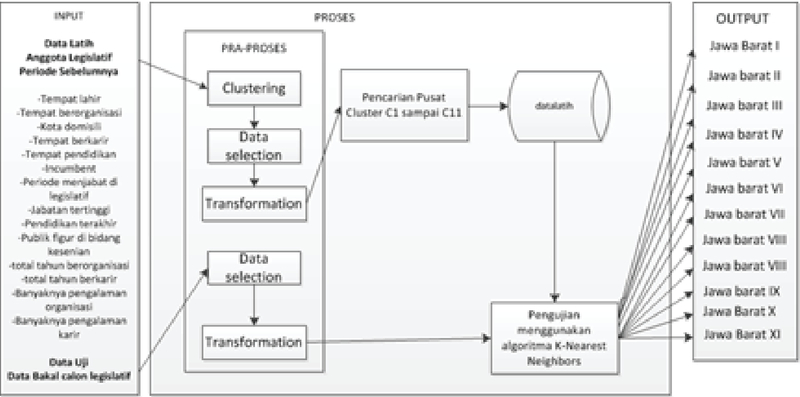Determining and Clustering Potential Legislative Candidate in West Java District Using K-Nearest Neighbors Algorithm
DOI:
https://doi.org/10.18502/kss.v2i4.865Abstract
Indonesia held its first general election in 1955 to elect legislatures from all provinces. The latest was held in 2014, which elected 560 members to the People's Representative Council (Dewan Perwakilan Rakyat, DPR) and 128 to the Regional Representative Council (Dewan Perwakilan Daerah, DPD). The PRC was elected by proportional representation from multi-candidate constituencies/districts. Currently, there are 77 constituencies in Indonesia, each of which returns 3-10 Members of Parliament based on population. Under Indonesia's new multi-party system, no party has been able to secure an outright victory; hence, selecting the right candidate for the right constituencies has been a major effort for all participating parties. Many combinations have been tried; popularities, intelligence, public figures, ‘putera daerah’ are all variables that can only show a fraction of winning pattern where no general conclusion can be drawn. This research used data mining techniques to create an unfound pattern, and to suggest which particular legislative candidate is most suitable for which constituency. Using 11 West Java constituencies (11 clusters), K-Nearest Neighbors (K-NN) algorithms, we found out that an 83.33% accuracy using data from 2014 general election.
References
Yesi Andri, N. K, and M. Sri, Seminar Nasional Informatika, ISSN: 1979-2328, Implementasi Teknik Data Mining Untuk Memprediksi Tingkat Kelulusan Mahasiswa Pada Universitas Bina Darma Palembang. Seminar Nasional Informatika ISS, 1979- 2328, 2013.
M. Ayub, K. Tanti, and C. Maresha, “Model Analisis Classification Dengan,” in J48 Untuk Data Mahasiswa dan Dosen Di Perguruan Tinggi. ISSN: 1979-3960, pp. 19–30, SNASTIA, 1979-3960, 2014.
S. L. B. Ginting, W. Zarman, and A. Darmawan, “Teknik Data Mining Untuk Memprediksi Masa Studi Mahasiswa Menggunakan Algoritma K-Nearest Neighborhood,” Jurnal Teknik Komputer Unikom, vol. 3, no. 2, pp. 29–34, 2014.
Edi Junadi, 2015. Penggunaan KNN (K-Nearest Neighbor) Untuk Klasifikasi Teks Berita Yang Tak-Terkelompokkan Pada Saat Pengklasteran Oleh STC (Suffix Tree Clustering). Vol. 9, ISSN: 1979-8911.
N. Krisandi, Helmi, and B. Prihandono, “Algoritma K-Nearest Neighbors Dalam Klasifikasi Data Hasil Produksi Kelapa Sawit pada PT. Minamas Kecamatan Parindu,” Buletin Ilmiah Math. Stat. dan Terapannya (Bimaster), vol. 2, no. 1, pp. 33–38, 2013.
F. Kusumaningrum and S. S. Imas, “Klasifikasi Kemunculan Titik Panas pada Lahan Gambut di Sumatera dan Kalimantan Menggunakan Algoritma K-Nearest Neighbor,” Makalah Koloklum Program S1 Ilmu Komputer Alih Jenis, 2013.
H. Leidyana, “Penerapan Algoritma K-Nearest Neighbor Untuk Penentuan Resiko Kredit Kepemilikan Kendaraan Bemotor. Jurnal Penelitian Ilmu Komputer,” System embedded & Logic, vol. 1, no. 1, pp. 65–76, 2013.
A. G. Mabrur and L. Riani, “Penerapan Data Mining Untuk Memprediksi Kriteria Nasabah Kredit,” Jurnal Komputerdan Informatika (KOMPUTA), 2012.
I. Menarianti, “Klasifikasi Data Mining Dalam Menentukan Pemberian Kredit Bagi Nasabah Koperasi,” Jurnal Ilmiah teknosains, vol. 1, 2015.
R. I. Ndaumanu, Kusrini, and R. M. Arief, “Kusrini Arief,” Analisis Prediksi Tingkat Pengunduran Diri Mahasiswa dengan Metode K-Nearest Neighbor. Jatisi, vol. 1, no. 1, pp. 1–15, 2014.
Nursalim. Suprapedi and H. Himawan, “Klasifikasi Bidang Kerja Lulusan Menggunakan Algoritma K-Nearest Neighbor,” Jurnal Tekonologi Informasi, vol. 10, no. 1, pp. 31–43, 2014.
E. S. Y. Pandie, “Implementasi Algoritma Data Mining K-Nearest Neighbour (KNN) Dalam Pengambilan Keputusan Pengajuan Kredit,” Seminar Nasional Sains dan teknik, pp. 31–34, 2012.
H. Risman, N. Didik, and R. W. Yustina, “Penerapan Metode K-Nearest Neighbor Pada Aplikasi Penentu Penerima Beasiswa Mahasiswa Di STMIK Sinar Nusantara Surakarta,” ISSN: 2338-4018, pp. 2338–4018, 2013.
M. Shouman, T. Tim, and S. Rob, “Applying K-Nearest Neighbor in Diagnosing Heart Disease Patients,” in International Journal of Information and Education Technology 2, vol. 2, p. 3, 2012.
J. W. Yodha and W. K. Achmad, “Pengenalan Motif Batik Menggunakan Deteksi Tepi Canny dan K-Nearest Neighbor,” Techno.com, vol. 13, pp. 251–262, 2014.

